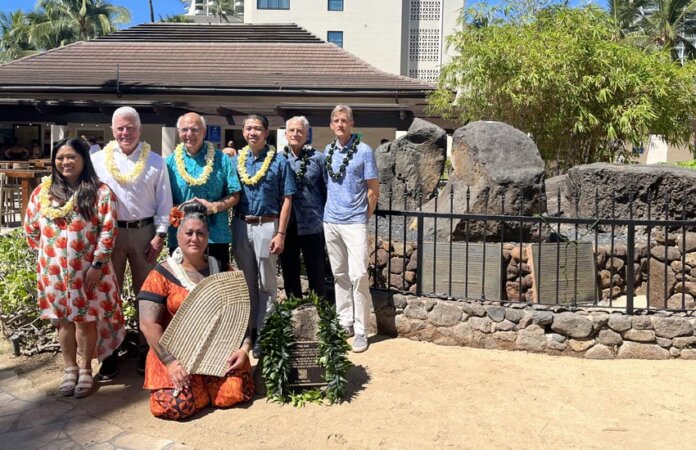Preserving the Original Story of Kapaemahu
As a child in the 1980s, Hinaleimoana Wong-Kalu remembers swimming with her friends at Waikīkī Beach and then, cold and wet, sitting on the warm Kapaemahu Stones to dry off a bit before going home. At the time, she and her friends did not know the significance, or the story, of the stones, nor did she think that 30 years in the future she would be part of an effort to preserve and document the moʻolelo behind them.
For decades, the Kapaemahu Stones were actually forgotten, neglected, and – during WWII – buried beneath a bowling alley as the wahi pana of Waikīkī was irrevocably transformed from a wetland ecosystem into an urban playground for tourists.
In 1963, the stones were rediscovered after the bowling alley was demolished. Renowned teacher and historian Mary Kawena Pukuʻi knew the story of the stones, understood their cultural significance, and insisted they be preserved.
Pukuʻi said that the name, Kapaemahu, means “a row of māhū.” But the plaque that was installed at the site called them “The Wizard Stones of Kapaemahu” (without translating “Kapaemahu”) and said they represented four “soothsayers” famous for their healing skills.
In 1997, as part of an effort to restore Hawaiian culture and history in Waikīkī, the site was renovated and rededicated. The stones were placed on an elevated platform, enclosed inside a fence and the surrounding area was planted with native medicinal plants. The effort was led by historian George Kanahele and traditional healer “Papa” Henry Auwae. To this day, Auwae’s haumāna serve as the caretakers of stones.
Still, the story about the stones shared on the signage did not include the detail that the healers were māhū or, significantly, that this contributed to their miraculous abilities.
Wong-Kalu heard a moʻolelo about Kapaemahu while she was studying at UH Mānoa in the 90s. Years later, she shared the moʻolelo with filmmakers Dean Hamer and Joe Wilson while working with them on a documentary. But there were other versions of the story out there too.
Intrigued, Hamer began to research the moʻolelo and incredibly, in 2015, he discovered an original manuscript recounting the story of Kapaemahu. It was written by James ʻAʻalapuna Harbottle Boyd, who served both King Kalākaua and Queen Liliʻuokalani. Boyd’s manuscript was published in Thrum’s Almanac in 1907.
Kapaemahu is the story of four travelers who bring healing arts to Hawaiʻi from Kahiki. They are described as “māhū” being masculine in appearance, but feminine in nature. The account related by Boyd, which some speculate was told to him by Liliʻuokalani herself, leaves little room for debate as to the true nature of the four healers. Moreover, Boyd says that it was their duality of spirit that augmented their healing powers.
“When I discovered the original manuscript, then dug through all the available newspapers and other sources from then until now, I began to understand how and why the story had been changed,” Hamer recalled. “That’s when it dawned on me that Kapaemahu is more than a story – it is a living record of a century of suppression and censorship.”
In addition to working on an academy-award nominated animated short film about the moʻolelo, a children’s book, and an exhibit at Bishop Museum, Hamer, Wilson and Wong-Kalu began working to get the signage for the monument changed.
That turned out to be a decade-long process that involved the City & County of Honolulu, the Mayor’s office and negotiation with the caretakers of the stones.
“After learning the deeper meaning of the moʻolelo and thinking about all that’s lost when people are denied knowledge of their history, it was clear that this was something we had to do,” Wilson reflected. “Not doing something to help right the wrongs of the past would simply be maintaining the status quo, which is unacceptable.
In traditional times, māhū had a place of honor and respect in Hawaiian society. Tuti Kanahele, a native speaker and university language instructor, says that māhū had kuleana for genealogy, healing, storytelling and hula and that without them, this knowledge would be lost.
Lynette Paglinawan, a social worker and expert in hoʻoponopono explains that Hawaiians recognized that duality exists within everyone: “We have a ʻKu’ and a ‘Hina.’ We have a hard and a soft. We have a male and we have a female.”
This understanding and social acceptance of māhū was shared throughout the Pacific. Similarly, the notion of duality is characterized as “two-spirit” in many Native American tribes. According to the Indian Health Service, “In most tribes they were considered neither men nor women; they occupied a distinct, alternative gender status.”
Sadly, assimilation into Western culture and adoption of a Western lens has diminished the status and role of māhū within many Indigenous communities and precipitated discrimination against them.
On Oct. 24, 2023, a new bronze plaque for the stones was dedicated – a victory after so many years of advocacy and negotiation. It features a QR code which takes visitors to www.kapaemahu.info. The site includes detailed information about the history and cultural significance of the stones, a guided virtual tour app, and a link to the animated short film, Kapaemahu.
“It is a testament to the sophistication of Hawaiian society that our people knew there was much more than simply a gender binary existence, much more than just the physicality of our existence – that the heart, mind and spirit all culminate to make a whole person,” Wong-Kalu said. “They understood that one’s sexuality and preference, and one’s gender expression, is irrelevant in articulating who our people are and insufficient in speaking to our roles and responsibilities in society or the contributions we can make.”
Full article here.
